Electronic Monitoring Statistics Publication, England and Wales: September 2025
Published 16 October 2025
Applies to England and Wales
1. Main points
The Electronic Monitoring Statistics publication covers the use and delivery of electronic monitoring in England and Wales, using four types of devices: curfew monitoring devices (also known as radio frequency or RF devices), location monitoring devices (also known as global positioning system or GPS devices), alcohol monitoring (AM) devices, and non-fitted devices (NFDs). A small number of individuals in the immigration cohort living in Scotland and Northern Ireland are also monitored.
This publication sets out statistics on the use of electronic monitoring as at 30 September 2025 compared to those as at 30 June 2025.
- The total number of individuals monitored with an electronic monitoring device was 26,647 as at 30 September 2025, an increase of 4% from 25,562 as at 30 June 2025.
Figure 1: Number of individuals monitored with an electronic monitoring device, by order type (excluding Specials[footnote 1]), England and Wales, as at 30 September 2025 (Source: Table 1.1)
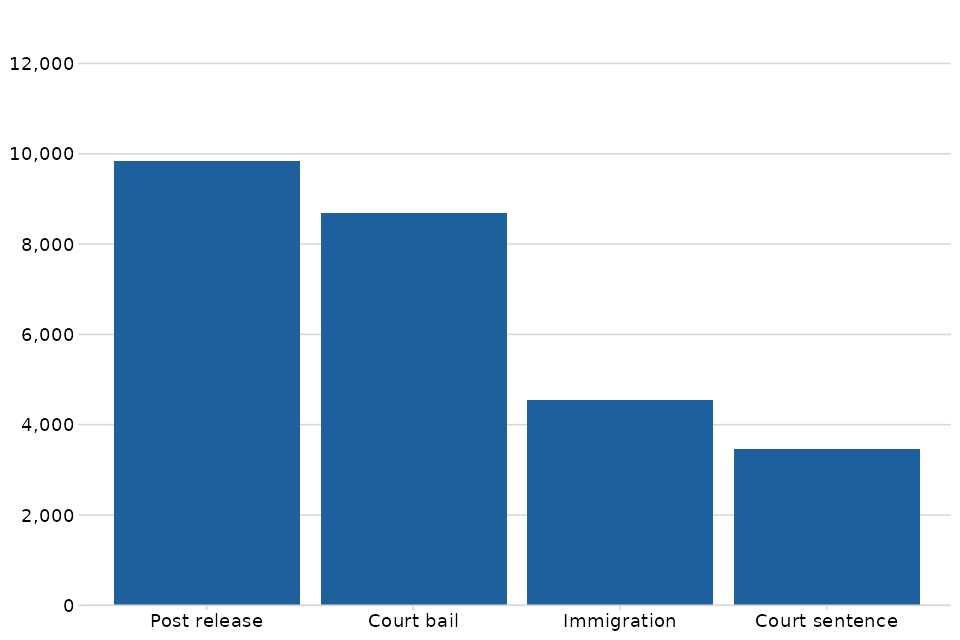
- Post release orders were the largest group with 9,844 individuals (37% of the caseload). This compares to 9,507 orders as at 30 June 2025, a 4% increase.
- Court bail orders made up the second-largest proportion with 8,686 individuals (33% of the caseload) of electronically monitored individuals. This compares to 8,277 orders as at 30 June 2025, a 5% increase.
- Immigration orders were the third-largest group with 4,551 individuals (17% of the caseload). This compares to 4,166 orders as at 30 June 2025, a 9% increase.
- Court sentences (community orders and suspended sentence orders) were the fourth-largest group with 3,473 individuals (13% of the caseload). This compares to 3,511 orders as at 30 June 2025, a 1% decrease.
Figure 2: Number of individuals monitored with an electronic monitoring device, by tag type (excluding Specials[footnote 1]), England and Wales, as at 30 September 2025 (Source: Table 2.1,3,1,4.1)
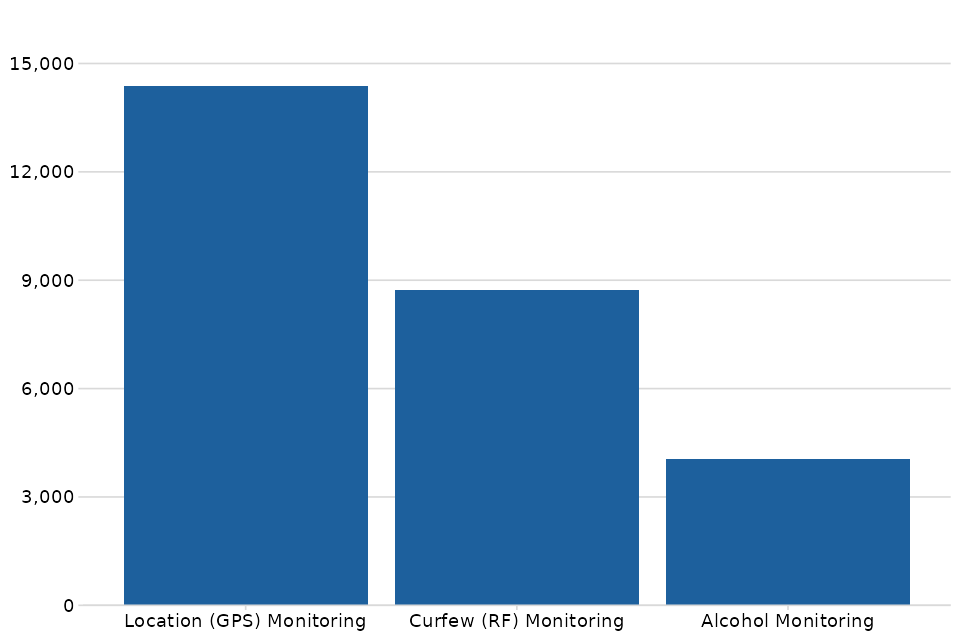
- Location Monitoring (GPS) devices account for 54% (14,386) of total individuals fitted and monitored. This compares to 12,975 orders as at 30 June 2025, an 11% increase.
- Curfew (RF) devices account for 33% (8,727) of individuals fitted and monitored. This compares to 9,016 orders as at 30 June 2025, a 3% decrease.
- Alcohol Monitoring (AM) devices account for 15% (4,059) of individuals fitted and monitored.
- Percentages may not sum to 100% as some individuals are fitted with more than one type of device.
2. Data quality
New contracts to deliver the Electronic Monitoring service were awarded in October 2023, with Serco taking over the delivery of the service from Capita in May 2024. Details of the contracts can be found here.
To maintain high standards of accuracy and quality, the publication of official statistics was temporarily paused. This allowed us to amend processes to produce statistics suitable for the new data source and to assess the data to ensure its accuracy.
This assurance work includes ongoing efforts to minimise duplicate and inconsistent records, which may occur as a result of both systems operating the EM service concurrently.
Prior to June 2025, it is not possible to reliably count unique individuals using the two systems, due to a high-level inconsistency between the two operating systems and data quality concerns. Some individuals appear in both systems, and some only in one, and there is no common unique identifier for individuals between the two systems. This is further hindered by missing or inconsistent person identifiable data to enable suitable identification.
These data quality issues have affected the caseload statistics, new orders and completed orders for curfew monitoring (RF) and location monitoring (GPS) prior to June 2025. We will consider whether anything can be done in the future to estimate this missing data.
As the service continues to transition between systems, data has been compiled from multiple sources. We have actively identified and removed duplicate records by matching between the two systems and have published statistics where we are confident such records account for less than 5% of the caseload and will continue to review data for subsequent publications.
Methodological changes
The caseload statistics for curfew monitoring (RF), location monitoring (GPS) and alcohol monitoring presented in this release are not directly comparable to those published previously due to changes in the definition and methodology used to classify individuals as “tagged”. As a result, caseload statistics are provided from June 2025 onwards.
Previous definition: An individual was considered tagged if they had any equipment assigned to at least one of their orders.
New definition: An individual is now considered tagged if all of the following conditions are met:
- Equipment is assigned to at least one of the orders, through a successful visit;
- The minimum required components for device monitoring have been input so that at least one monitoring requirement is fully met. Monitoring requirements are created to enable the monitoring of seven possible enforceable conditions.
- There has been at least one confirmed successful installation of the device.
3. Background
Electronic monitoring supports probation services, prisons, courts, the police, the Home Office, and the wider justice system in England and Wales. It is a way of remotely monitoring and recording information on an individual’s whereabouts or alcohol consumption, using an electronic device that is typically fitted to an individual’s ankle. Electronic monitoring may be used:
- as a condition of court bail;
- as a requirement of a court sentence, primarily community orders and suspended sentence orders;
- for Home Detention Curfew;
- as a licence condition following release from custody;
- as a condition of immigration bail, managed by the Home Office; or
- to intensively monitor a small number of individuals, including: some of the highest-risk offenders managed under Multi-Agency Public Protection Arrangements (MAPPA); those granted bail by the Special Immigration Appeals Commission (SIAC); and those made subject to Terrorism Prevention and Investigation Measures (TPIMs).
An individual may be given several orders at the same time and/or over the course of a year. Therefore, it is likely that there will be more active orders at any one time than there are people being monitored and some individuals will be dual-tagged. If an individual has multiple orders:
- when counting order notifications, each notification will be counted separately;
- when counting individuals, the individual will be included in one order cohort once according to a defined formula.
Please see the technical note for more details.
4. Location Monitoring (GPS)
Location monitoring (GPS) devices allow the monitoring of:
- compliance with exclusion zones;
- attendance at a required activity or appointment;
- an offender’s whereabouts, known as trail monitoring;
- multiple conditions or requirements, if necessary, such as a combination of exclusion zones, curfew, monitored attendance and trail monitoring.
Between 30 June 2025 and 30 September 2025, the number of individuals monitored with an electronic monitoring device and whose primary order was a location monitoring (GPS) order increased from 12,975 individuals to 14,386, an increase of 11%.
Figure 3: Number of individuals monitored with a location monitoring (GPS) device, by order type (excluding Specials[footnote 1]), England and Wales, as at 30 September 2025 (Source: Table 3.1)
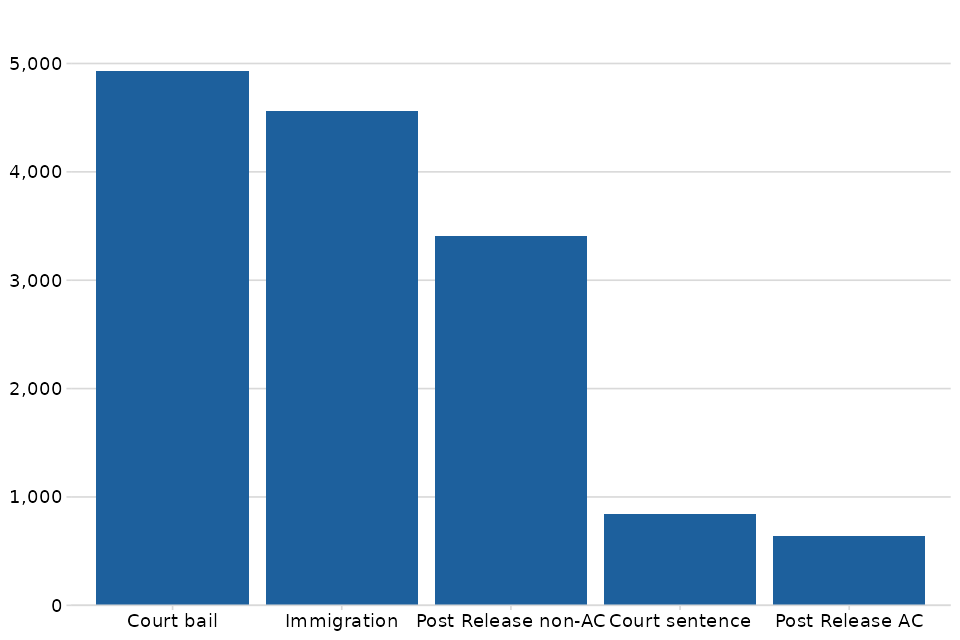
- Court bail orders make up the largest proportion (34%) of location monitored (GPS) individuals. At 30 September 2025, 4,935 individuals had location monitoring (GPS) court bail as their primary order type, an increase of 13% compared to 30 June 2025.
- Immigration orders were the second largest group with 4,558 individuals (32% of the caseload), up by 9% when compared with 30 June 2025.
- Post release non-AC(Acquisitive Crimes) orders were the third largest group with 3,408 individuals (24% of the location monitoring (GPS) caseload), up by 12% when compared to 30 June 2025.
- Court sentence orders (community orders and suspended sentence orders) were the fourth largest group with 846 individuals (6% of the caseload), up by 11% when compared with 30 June 2025.
- Post release AC orders were the fifth largest group with 639 individuals (4% of the location monitoring (GPS) caseload), up by 5% when compared to 30 June 2025.
5. Non-Fitted Devices (NFDs)
Electronic monitoring using a non-fitted device was introduced in November 2022 for the immigration cohort. These devices utilise periodic biometric verification as an alternative to fitted devices. Individuals with a non-fitted device have been included within the location monitoring (GPS) cohort for the purposes of this analysis.
6. Curfew Monitoring (RF)
Curfew monitoring devices allow the monitoring of a curfew, where an offender must be at a specified location at specified times.
Between 30 June 2025 and 30 September 2025 the total number of individuals monitored with an electronic monitoring device and whose primary order was a curfew monitoring order decreased by 3% from 9,016 individuals to 8,727.
Figure 4: Number of individuals monitored with a curfew monitoring device, by order type (excluding Specials[footnote 1]), England and Wales, as at 30 September 2025 (Source: Table 2.1)
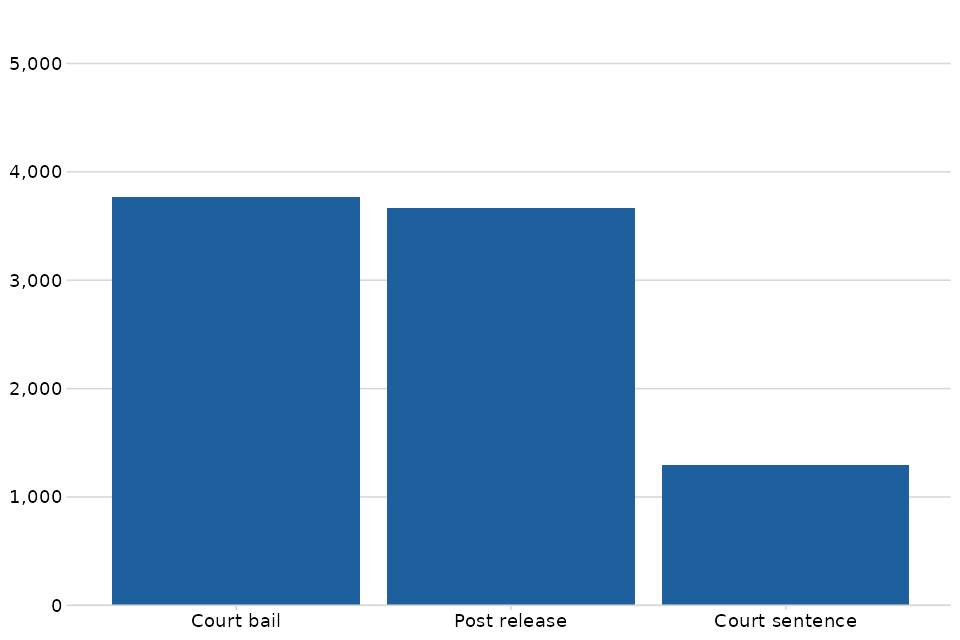
- Court bail orders make up the largest proportion (43%) of curfew monitoring (RF) individuals. At 30 September 2025, 3,768 individuals had curfew monitoring (RF) court bail as their primary order type, a decrease of 4% since 30 June 2025.
- Post release orders were the second largest group with 3,663 individuals (42% of the curfew monitoring (RF) caseload), down by 6% when compared with 30 June 2025.
- Court sentence orders (community orders and suspended sentence orders) were the third largest group with 1,296 individuals (15% of the caseload), up by 6% when compared with 30 June 2025.
- As at 30 September 2025, there are no individuals that had immigration curfew monitoring (RF) orders as their primary order type. Home Office Immigration Enforcement (HOIE) have primarily used location monitoring (GPS) tags since 2021.
7. Alcohol Monitoring
Migration of alcohol monitoring orders from Capita to Serco began at the end of July 2025. As with curfew (RF) and location (GPS) monitoring, the definition and methodology for reporting alcohol monitoring caseload statistics have been updated to align with the revised definition used across all electronic monitoring caseloads (as mentioned earlier). The number of new and completed alcohol monitoring orders is not impacted by the change of definition.
There are two types of alcohol monitoring:
- Alcohol Abstinence and Monitoring Requirement (AAMR) – this may only be used when sentencing for alcohol-related criminal behaviour and it imposes a total ban on drinking alcohol for up to 120 days. Compliance with the ban is monitored electronically using an alcohol monitoring device, which monitors for the consumption of alcohol via an offender’s sweat. An AAMR can only be imposed if the individual is not alcohol dependent or has an Alcohol Treatment Requirement (ATR), and the individual is an adult (18 years or over).
- Alcohol Monitoring on Licence (AML) – this is an additional licence condition for offenders released from custody whose offending and risk is alcohol related. There are two licence conditions available, total abstinence from alcohol, or a requirement that the offender complies with requirements specified by their probation practitioner to address their alcohol needs, which will include restricting alcohol consumption.
The total number of individuals monitored with an alcohol monitoring device as at 30 September 2025 was 4,059.
Figure 5: Number of new alcohol monitoring orders, England and Wales, monthly from January 2022 to August 2025 (Source: Table 4.2)
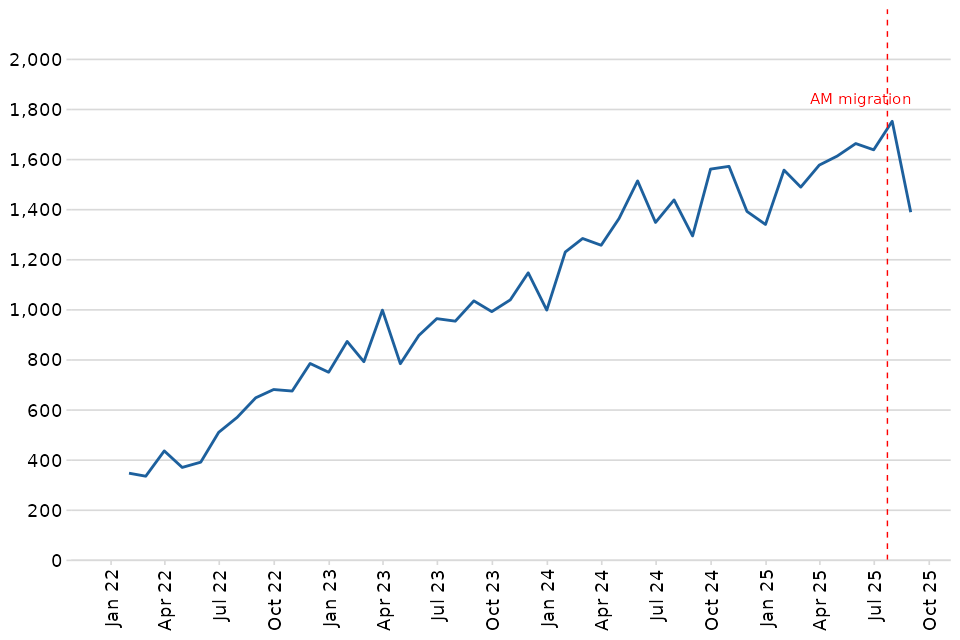
There were 4,782 new alcohol monitoring orders imposed across England and Wales between June 2025 and August 2025. Overall, 49,910 new alcohol monitoring orders have been imposed since their introduction.
8. Further information
Accompanying files
As well as this bulletin, the following products are published as part of this release:
-
Data tables
-
Technical note
Official Statistics
Our statistical practice is regulated by the Office for Statistics Regulation (OSR). OSR sets the standards of trustworthiness, quality, and value in the Code of Practice for Statistics that all producers of official statistics should adhere to. You are welcome to contact us directly with any comments about how we meet these standards.
This publication has been produced to the high professional standards as set out in the Code of Practice for Statistics. Data limitations are set out earlier in this report.
For further details on the methodology used to compile the report, please refer to the technical note.
Future publications
Our statisticians regularly review the content of publications. Development of new and improved statistical outputs is usually dependent on reallocating existing resources. As part of our continual review and prioritisation, we welcome user feedback on existing outputs including content, breadth, frequency and methodology. Please send any comments you have on this publication including suggestions for further developments or reductions in content to ppas_statistics@justice.gov.uk
Contact
Press enquiries should be directed to the Ministry of Justice press office.
Other enquiries about these statistics should be directed to Youth Justice and Offender Policy Directorate at the Ministry of Justice:
HMPPS Electronic Monitoring Performance
Youth Justice and Offender Policy
Ministry of Justice
10th Floor
102 Petty France
London
SW1H 9AJ
Email: ppas_statistics@justice.gov.uk
Next update: Jan 2026
© Crown copyright Produced by the Ministry of Justice
Alternative formats are available on request from ppas_statistics@justice.gov.uk
-
Please refer to Annex A within the technical note ↩ ↩2 ↩3 ↩4
